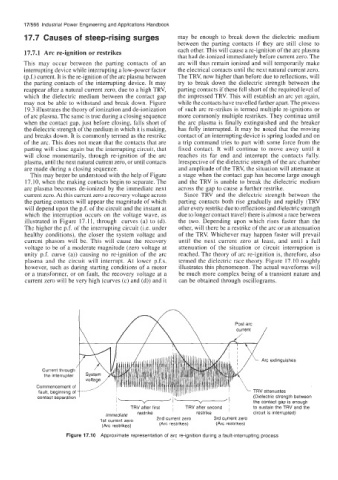Page 601 - Industrial Power Engineering and Applications Handbook
P. 601
17/566 Industrial Power Engineering and Applications Handbook
17.7 Causes of steep-rising surges may be enough to break down the dielectric medium
between the parting contacts if they are still close to
17.7.1 Arc re-ignition or restrikes each other. This will cause a re-ignition of the arc plasma
that had de-ionized immediately before current zero. The
This may occur between the parting contacts of an arc will thus remain ionized and will temporarily make
interrupting device while interrupting a low-power factor the electrical contacts until the next natural current zero.
(p.f.) current. It is the re-ignition of the arc plasma between The TRV, now higher than before due to reflections, will
the parting contacts of the interrupting device. It may try to break down the dielectric strength between the
reappear after a natural current zero, due to a high TRV, parting contacts if these fell short of the required level of
which the dielectric medium between the contact gap the impressed TRV. This will establish an arc yet again,
may not be able to withstand and break down. Figure while the contacts have travelled farther apart. The process
19.3 illustrates the theory of ionization and de-ionization of such arc re-strikes is termed multiple re-ignitions or
of arc plasma. The same is true during a closing sequence more commonly multiple restrikes. They continue until
when the contact gap, just before closing, falls short of the arc plasma is finally extinguished and the breaker
the dielectric strength of the medium in which it is making, has fully interrupted. It may be noted that the moving
and breaks down. It is commonly termed as the restrike contact of an interrupting device is spring loaded and on
of the arc. This does not mean that the contacts that are a trip command tries to part with some force from the
parting will close again but the interrupting circuit, that fixed contact. It will continue to move away until it
will close momentarily, through re-ignition of the arc reaches its far end and interrupt the contacts fully.
plasma, until the next natural current zero, or until contacts Irrespective of the dielectric strength of the arc chamber
are made during a closing sequence. and amplitude of the TRV, the situation will attenuate at
This may better be understood with the help of Figure a stage when the contact gap has become large enough
17.10, when the making contacts begin to separate. The and the TRV is unable to break the dielectric medium
arc plasma becomes de-ionized by the immediate next across the gap to cause a further restrike.
current zero. At this current zero a recovery voltage across Since TRV and the dielectric strength between the
the parting contacts will appear the magnitude of which parting contacts both rise gradually and rapidly (TRV
will depend upon the p.f. of the circuit and the instant at after every restrike due to reflections and dielectric strength
which the interruption occurs on the voltage wave, as due to longer contact travel) there is almost a race between
illustrated in Figure 17.11, through curves (a) to (d). the two. Depending upon which rises faster than the
The higher the p.f. of the interrupting circuit (Le. under other, will there be a restrike of the arc or an attenuation
healthy conditions), the closer the system voltage and of the TRV. Whichever may happen faster will prevail
current phasors will be. This will cause the recovery until the next current zero at least, and until a full
voltage to be of a moderate magnitude (zero voltage at attenuation of the situation or circuit interruption is
unity p.f. curve (a)) causing no re-ignition of the arc reached. The theory of arc re-ignition is, therefore, also
plasma and the circuit will interrupt. At lower p.f.s, termed the dielectric race theory. Figure 17.10 roughly
however, such as during starting conditions of a motor illustrates this phenomenon. The actual waveforms will
or a transformer, or on fault, the recovery voltage at a be much more complex being of a transient nature and
current zero will be very high (curves (c) and (d)) and it can be obtained through oscillograms.
Arc extinguishes
Current through
the interrupter
Commencement of
fault, beginning of
contact separation (Dielectric strength between
the contact gap is enough
i TRV after first i TRV after second i to sustain the TRV and the
restrike circuit is interrupted)
Immediate restrike
1st current zero 2nd current zero 3rd current zero
(Arc restrikes) (Arc restrikes) (Arc restrikes)
Figure 17.10 Approximate representation of arc re-ignition during a fault-interrupting process

